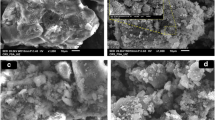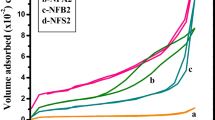Abstract
This study investigated the removal of Orange-G dye (OG) using a hybrid adsorbent developed from Opuntia Ficus Indica (OFI) activated with NaOH (OFI-A) were reinforced by polyaniline (PANI) by a fast chemical method. PANI@OFI-A and OFI-A adsorbents having different physicochemical characteristics as FTIR, XRD, TGA, SEM and nitrogen adsorption isotherms are used to analyze the structure of the resulting materials. Besides, the effect of several parameters including contact time (0–24 h), pH (1–12) and initial OG concentration (300–1000 mg L−1) were evaluated on the adsorption efficiency. The modified OFI-A by PANI was employed as an excellent adsorbent for the removing of OG from aqueous solutions. The results indicated that OG adsorption basically relies on adsorbing time, solution pH and initial OG concentration. Furthermore, the PANI@OFI-A also shows a high adsorption capacity of 303.94 mg g−1 for OG, quite higher than that of OFI-A (8.04 mg g−1). The kinetic results were adapted well to the pseudo second order kinetic model resemble chemisorption by two samples prepared. Based on the obtained results, the PANI@OFI-A has potential to be used in sensitive environment that need to completely remove OG.









Similar content being viewed by others
References
B.K. Hordern, M. Ziółek, J. Nawrocki, Catalytic ozonation and methods of enhancing molecular ozone reactions in water treatment. Appl. Catal. B 46, 639–669 (2003)
Z. Yang, T.A. Asoh, H. Uyama, Removal of cationic or anionic dyes from water using ion exchange cellulose monoliths as adsorbents. Bull. Chem. Soc. Jpn. 92, 1453–1461 (2019)
E. Ghiasi, A. Malekzadeh, Removal of various textile dyes using LaMn(Fe)O3 and LaFeMn0.5O3 nanoperovskites; RSM optimization, isotherms and kinetics studies. J. Inorg. Organometal. Polym. Mater. 30, 2789–2804 (2020)
Y. Tang, X. Yin, M. Mu, Y. Jiang, X. Li, H. Zhang, T. Ouyang, Anatase TiO2@MIL-101(Cr) nanocomposite for photocatalytic degradation of bisphenol A. Colloids Surf. A 596, 124745 (2020)
M. Ballesteros Martín, J. Sánchez Pérez, J. García Sánchez, L. Montes de Oca, J. Casas López, I. Oller, S. Malato Rodríguez, Degradation of alachlor and pyrimethanil by combined photo-Fenton and biological oxidation. J. Hazard. Mater. 155, 342–349 (2008)
H. Laksaci, A. Khelifi, B. Belhamdi, M. Trari, The use of prepared activated carbon as adsorbent for the removal of Orange-G from aqueous solution. Microchem. J. 145, 908–913 (2019)
H. Murthy, H. Manonmani, Aerobic degradation of technical hexachlorocyclohexane by a defined microbial consortium. J. Hazard. Mater. 149, 18–25 (2007)
A. Ahmad, L. Tan, S. Shukor, Dimethoate and atrazine retention from aqueous solution by nanofiltration membranes. J. Hazard. Mater. 151, 71–77 (2008)
M. Maldonado, S. Malato, L. Pérez-Estrada, W. Gernjak, I. Oller, X. Doménech, J. Peral, Partial degradation of five pesticides and an industrial pollutant by ozonation in a pilot-plant scale reactor. J. Hazard. Mater. 138, 363–369 (2006)
A. Belalia, A. Zehhaf, A. Benyoucef, Preparation of hybrid material based of PANI with SiO2 and its adsorption of phenol from aqueous solution. Polym. Sci. Ser. B 60, 816–824 (2018)
M. Mekhloufi, A. Zehhaf, A. Benyoucef, C. Quijada, E. Morallon, Removal of 8-quinolinecarboxylic acid herbicide from aqueous solution by adsorption on activated-montmorillonites. Environ. Monit. Assess. 185, 10365–10375 (2013)
Y. Su, M. Ji, J. Li, C. Chang, S. Dong, Y. Deng, Y. Yang, L. Gu, Subcritical fluid extraction treatment on egg yolk: product characterization. J. Food Eng. 274, 109805 (2020)
E.T. Özer, B. Osman, B. Parlak, An experimental design approach for the solid phase extraction of some organophosphorus pesticides from water samples with polymeric microbeads. Microchem. J. 154, 104537 (2020)
A.M. Donia, A.A. Atia, W.A. Al-amrani, A.M. El-nahas, Effect of structural properties of acid dyes on their adsorption behaviour from aqueous solutions by amine modified silica. J. Hazard. Mater. 161, 1544–1550 (2009)
N. Ouasfi, S. Bouzekri, M. Zbair, H. Ait Ahsaine, S. Bakkas, M. Bensitel, L. Khamliche, C. Doukkali, E. Jadida, Carbonaceous material prepared by ultrasonic assisted pyrolysis from algae (Bifurcaria bifurcata): response surface modeling of aspirin removal. Surf. Interfaces 14, 61–71 (2019)
A. Elouahli, M. Zbair, Z. Anfar, H.A. Ahsaine, H. Khallok, R. Chourak, Z. Hatim, Apatitic tricalcium phosphate powder: high sorption capacity of hexavalent chromium removal. Surf. Interfaces 13, 139–147 (2018)
M. Abdelsalam, S.A. Kosa, A.A. Al-Beladi, Application of nanoclay for the adsorptive removal of Orange G dye from aqueous solution. J. Mol. Liq. 241, 469–477 (2017)
A. Hsini, A. Essekri, N. Aarab, M. Laabd, A.A. Addi, R. Lakhmiri, A. Albourine, Elaboration of novel polyaniline@almond shell biocomposite for effective removal of hexavalent chromium ions and Orange G dye from aqueous solutions. Environ. Sci. Pollut. Res. 27, 15245–15258 (2020)
T. Sen, S. Mishra, N.G. Shimpi, Synthesis and sensing applications of polyaniline nanocomposites: a review. RSC Adv. 6, 42196–42222 (2016)
K. Akag, Interdisciplinary chemistry based on integration of liquid crystals and conjugated polymers: development and progress. Bull. Chem. Soc. Jpn. 92, 1509–1655 (2019)
S. Benykhlef, A. Bekhoukh, R. Berenguer, A. Benyoucef, E. Morallon, PANI-derived polymer/Al2O3 nanocomposites: synthesis, characterization and electrochemical studies. Colloid Polym. Sci. 294, 1877–1885 (2016)
F. Chouli, I. Radja, E. Morallon, A. Benyoucef, A novel conducting nanocomposite obtained by p-anisidine and aniline with titanium(IV) oxide nanoparticles: synthesis, characterization, and electrochemical properties. Polym. Compos. 38, 254–260 (2017)
S. Daikh, F.Z. Zeggai, A. Bellil, A. Benyoucef, Chemical polymerization, characterization and electrochemical studies of PANI/ZnO doped with hydrochloric acid and/or zinc chloride: differences between the synthesized nanocomposites. J. Phys. Chem. Solids 121, 78–84 (2018)
F.Z. Kouidri, R. Berenguer, A. Benyoucef, E. Morallon, Tailoring the properties of polyanilines/SiC nanocomposites by engineering monomer and chain substituents. J. Mol. Struct. 1188, 121–128 (2019)
D. Ouis, F.Z. Zeggai, A. Belmokhtar, A. Benyoucef, B. Meddah, K. Bachari, Role of p-benzoquinone on chemically synthesized nanocomposites by polyaniline with V2O5 nanoparticle. J. Inorg. Organometal. Polym. Mater. (2020). https://doi.org/10.1007/s10904-020-01508-7
E.S. Lyle, C. McAllister, D.C. Dahn, R. Bissessur, Exfoliated MoS2-polyaniline nanocomposites: synthesis and characterization. J. Inorg. Organomet. Polym. Mater. 30, 206–213 (2020)
E. Parthiban, N. Kalaivasan, S. Sudarsan, Dual responsive (pH and magnetic) nanocomposites based on Fe3O4@polyaniline/itaconic acid: synthesis, characterization and removal of toxic hexavalent chromium from tannery wastewater. J. Inorg. Organomet. Polym. Mater. 30, 4677–4690 (2020)
M.K.M. Nodeh, S. Soltani, S. Shahabuddin, H.R. Nodeh, H. Sereshti, Equilibrium, kinetic and thermodynamic study of magnetic polyaniline/graphene oxide based nanocomposites for ciprofloxacin removal from water. J. Inorg. Organomet. Polym. Mater. 28, 1226–1234 (2018)
K.K. Beltrame, A.L. Cazetta, P.S.C. de Souza, L. Spessato, T.L. Silva, V.C. Almeida, Adsorption of caffeine on mesoporous activated carbon fibers prepared from pineapple plant leaves. Ecotoxicol. Environ. Saf. 147, 64–71 (2018)
G. Yang, S. Song, J. Li, Z. Tang, J. Ye, J. Yang, Preparation and CO2 adsorption properties of porous carbon by hydrothermal carbonization of tree leaves. J. Mater. Sci. Technol. 35, 875–884 (2019)
S. Wong, H.H. Tumari, N. Ngadi, N.B. Mohamed, O. Hassan, R. Mat, N.A.S. Amin, Adsorption of anionic dyes on spent tea leaves modified with polyethyleneimine (PEI-STL). J. Clean. Prod. 206, 394–406 (2019)
Y. Hu, Y. Zhu, Y. Zhang, T. Lin, G. Zeng, S. Zhang, Y. Wang, W. He, M. Zhang, H. Long, An efficient adsorbent: simultaneous activated and magnetic ZnO doped biochar derived from camphor leaves for ciprofloxacin adsorption. Bioresour. Technol. 288, 121511 (2019)
A. Ghazali, M. Shirani, A. Semnani, V.Z. Shahabadi, M. Nekoeinia, Optimization of crystal violet adsorption onto Date palm leaves as a potent biosorbent from aqueous solutions using response surface methodology and ant colony. J. Environ. Chem. Eng. 6, 3942–3950 (2018)
M. Muthu, D. Ramachandran, N. Hasan, M. Jeevanandam, J. Gopal, S. Chun, Unprecedented nitrate adsorption efficiency of carbon-silicon nano composites prepared from bamboo leaves. Mater. Chem. Phys. 189, 12–21 (2017)
O. Bensebia, K. Allia, Analysis of adsorption–desorption moisture isotherms of rosemary leaves. J. Appl. Res. Med. Aromat. Plants 3, 79–86 (2016)
S. Knani, F. Aouaini, N. Bahloul, M. Khalfaoui, M.A. Hachicha, A. BenLamine, N. Kechaou, Modeling of adsorption isotherms of water vapor on Tunisian olive leaves using statistical mechanical formulation. Phys. A 400, 57–70 (2014)
M. Choudhary, R. Kumar, S. Neogi, Activated biochar derived from Opuntia ficus-indica for the efficient adsorption of malachite green dye, Cu2+ and Ni2+ from water. J. Hazard. Mater. 392, 22441 (2020)
M. Choudhary, M.B. Ray, S. Neogi, Evaluation of the potential application of cactus (Opuntia ficus-indica) as a bio-coagulant for pre-treatment of oil sands process-affected water. Sep. Purif. Technol. 209, 714–724 (2019)
A.A.P. Cid, I.V. Ugalde, A.M.H. González, J.G. Serrano, Textile dyes removal from aqueous solution using Opuntia ficus-indica fruit waste as adsorbent and its characterization. J. Environ. Manag. 130, 90–97 (2013)
H. Soltani, A. Belmokhtar, F.Z. Zeggai, A. Benyoucef, S. Bousalem, K. Bachari, Copper(II) removal from aqueous solutions by PANI-clay hybrid material: fabrication, characterization, adsorption and kinetics study. J. Inorg. Organomet. Polym. Mater. 29, 841–850 (2019)
S. Kaushal, R. Badru, S. Kumar, H. Kaur, P. Singh, Efficient removal of cationic and anionic dyes from their binary mixtures by organic–inorganic hybrid material. J. Inorg. Organomet. Polym. Mater. 28, 968–977 (2018)
A.B. Wozniak, R. Pietrzak, Adsorption of organic and inorganic pollutants on activated bio-carbons prepared by chemical activation of residues of supercritical extraction of raw plants. Chem. Eng. J. 393, 124785 (2020)
W.A. Khanday, G. Kabir, B.H. Hameed, Catalytic pyrolysis of oil palm mesocarp fibre on a zeolite derived from low-cost oil palm ash. Energy Convers. Manag. 127, 265–272 (2016)
A. Sila, N. Sayari, R. Balti, O.M. Alvarez, N.N. Arroume, N. Moncef, A. Bougatef, Biochemical and antioxidant properties of peptidic fraction of carotenoproteins generated from shrimp by-products by enzymatic hydrolysis. Food Chem. 148, 445–452 (2014)
C.S. Pappas, A. Malovikova, Z. Hromadkova, P.A. Tarantilis, A. Ebringerova, M.G. Polissiou, Determination of the degree of esterification of pectinates with decyl and benzyl ester groups by diffuse reflectance infrared Fourier transform spectroscopy (DRIFTS) and curve-fitting deconvolution method. Carbohyd. Polym. 56, 465–469 (2004)
M. Choudhary, R. Kumar, S. Neogi, Activated biochar derived from Opuntia ficus-indica for the efficient adsorption of malachite green dye, Cu2+ and Ni2+ from water. J. Hazard. Mater. 392, 122441 (2020)
K. Kandasamy, M. Venkatesh, Y.A. SyedKhadar, P. Rajasingh, One-pot green synthesis of CdS quantum dots using Opuntia ficus-indica fruit sap. Mater. Today 26, 3503–3506 (2020)
D. Gopi, K. Kanimozhi, L. Kavitha, Opuntia ficus indica peel derived pectin mediated hydroxyapatite nanoparticles: synthesis, spectral characterization, biological and antimicrobial activities. Spectrochim. Acta A 141, 135–143 (2015)
C.Y. Gan, N.H.A. Manaf, A.A. Latiff, Physico-chemical properties of alcohol precipitate pectin-like polysaccharides from Parkia speciosa pod. Food Hydrocoll. 24, 471–478 (2010)
M. Ferriol, A. Gentilhomme, M. Cochez, N. Oget, J.L. Mieloszynski, Thermal degradation of poly (methyl methacrylate) (PMMA): modelling of DTG and TG curves. Polym. Degrad. Stab. 79, 271–281 (2003)
Y. Zhou, J. Lu, Y. Zhou, Y. Liu, Recent advances for dyes removal using novel adsorbents: a review. Environ. Pollut. 252, 352–365 (2019)
L. Ramrakhiani, S. Ghosh, A.K. Mandal, S. Majumdar, Utilization of multi-metal laden spent biosorbent for removal of glyphosate herbicide from aqueous solution and its mechanism elucidation. Chem. Eng. J. 361, 1063–1077 (2019)
M.M. Sadeghi, A.S. Rad, M. Ardjmand, A. Mirabi, Preparation of magnetic nanocomposite based on polyaniline/Fe3O4 towards removal of lead(II) ions from real samples. Synth. Met. 245, 1–9 (2018)
D. Shao, G. Hou, J. Li, T. Wen, X. Ren, X. Wang, PANI/GO as a super adsorbent for the selective adsorption of uranium(VI). Chem. Eng. J. 255, 604–612 (2014)
Acknowledgements
The Authors would like to acknowledge the Management DGRSDT of Algeria for the kind support of this investigation. We would also like to thanks the Instituto Universitario de Materiales of Alicante University in Spain. The Authors also would like to give special thanks to Prof Emilia Morallón for all his help.
Author information
Authors and Affiliations
Corresponding author
Ethics declarations
Conflict of interest
The authors declare no conflict of interest.
Additional information
Publisher's Note
Springer Nature remains neutral with regard to jurisdictional claims in published maps and institutional affiliations.
Rights and permissions
About this article
Cite this article
Mahi, O., Khaldi, K., Belardja, M.S. et al. Development of a New Hybrid Adsorbent from Opuntia Ficus Indica NaOH-Activated with PANI-Reinforced and Its Potential Use in Orange-G Dye Removal. J Inorg Organomet Polym 31, 2095–2104 (2021). https://doi.org/10.1007/s10904-020-01873-3
Received:
Revised:
Accepted:
Published:
Issue Date:
DOI: https://doi.org/10.1007/s10904-020-01873-3




